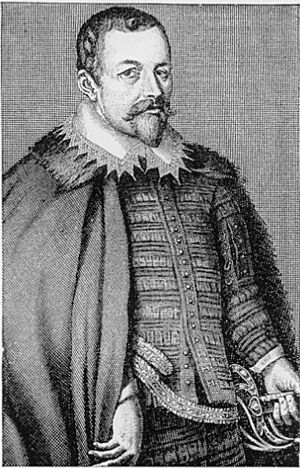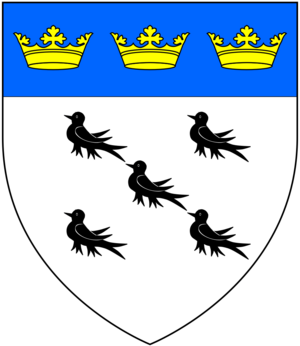Thomas Bodley facts for kids
Sir Thomas Bodley (born March 2, 1545 – died January 28, 1613) was an English diplomat and scholar. He is famous for starting the Bodleian Library in Oxford, which is one of the oldest and most important libraries in the world.
Contents
Early Life and Family
Thomas Bodley was born in the city of Exeter, Devon, on March 2, 1545. This was near the end of King Henry VIII's rule. His father, John Bodley, was a Protestant merchant.
During the time of Queen Mary (1553-1558), who was Roman Catholic, many Protestants faced danger. John Bodley chose to leave England and live in another country to stay safe. Because of this, he helped publish the Geneva Bible, an important Protestant translation of the Bible.
Thomas's mother was Joan Hone. He also had a younger brother named Sir Josias Bodley, who later became a knight in Ireland.
Growing Up and School
When Queen Mary was ruling, Thomas's family, including his younger brother Josias, moved to Europe for safety. They lived in places like Wesel and Frankfurt before settling in Geneva, Switzerland. Geneva was a big center for the Protestant Reformation and the home of Calvinism.
In Geneva, Thomas had a great chance to study at a new school started by John Calvin. He learned from famous scholars like Theodore Beza and Calvin himself. He also learned Greek and Hebrew, which he loved to study throughout his life.
After Queen Mary died in 1558, Queen Elizabeth became ruler, and the family returned to England. Thomas then went to Magdalen College, Oxford, to continue his studies. In 1563, he earned his first degree. Soon after, in 1564, he became a Fellow at Merton College.
Thomas Bodley later married Ann Ball, who was a wealthy widow. He did not have any children of his own.
A Career in Diplomacy
Thomas Bodley started teaching at Merton College. In 1565, he was officially named the college's first teacher of Ancient Greek. He also held several other important roles at the university.
In 1576, Bodley left Oxford to travel and study in other countries. He visited France, Italy, and the Holy Roman Empire. During his travels, he met many scholars and learned French, Italian, and Spanish.
When he returned to England, Queen Elizabeth appointed him as a gentleman-usher. This meant he was a personal attendant to the Queen. In 1584, he became a member of the House of Commons, representing Portsmouth.
Bodley was also sent on important diplomatic missions. In 1585, he worked to create an alliance between Frederick II of Denmark and German princes to help Henry of Navarre. He was also sent on a secret mission to France.
In 1588, he became a minister in The Hague, Netherlands. This job required great skill because it involved dealing with Spain's power. Bodley faced many challenges and often asked to return home.
Finally, in 1596, he was allowed to come back to England. He hoped to become Secretary of State, a very high position. However, due to conflicts between other powerful figures like Burghley and Essex, he decided to leave public life. He then returned to Oxford.
Founding the Bodleian Library
After leaving his career in government, Thomas Bodley decided to dedicate his life to a new project: restoring the old university library at Oxford. This library, called Duke Humfrey's Library, had been damaged and abandoned during the Reformation in the 1550s.
In February 1598, Bodley offered to restore the library, and the university accepted his idea. He said he wanted to "take his farewell of state employments and to set up his staff at the library door in Oxford." He started collecting books in 1600, using the old library building, which was almost ruined. The library was later named the Bodleian Library in his honor.
Even though Bodley lived over 400 years ago, some of his ideas are still used in libraries today.
The Benefactors' Book
One important idea Bodley had was creating a "Benefactors' Book" in 1602. This book was beautifully bound and put on display in the library in 1604. While Bodley had money from his wife and his father, he also needed gifts from his rich friends to build the library's collection.
Bodley knew that seeing their names on permanent display would encourage people to donate. He prepared a special book where the name of every donor would be written clearly. He kept this book where everyone visiting the library could see it. This plan worked very well, as many people wanted their names to be in the "scroll of the benefactors." This idea has inspired people to support libraries for centuries.
Some notable donations included fifty pounds from Sir Walter Raleigh in 1603 and a copy of Francis Bacon's book The Advancement of Learning, given by the author himself in 1605.
Legal Deposit Library
Another important achievement was an agreement between the Bodleian Library and the Stationers' Company. This company was in charge of registering all new books published in England.
The agreement stated that the Company would send the Bodleian Library a copy of every book registered with them. In return, the library would allow the Company to borrow books for reprinting and to examine books donated by others.
This made the Bodleian the first "legal deposit" library. This means it has the right to receive a copy of every book published in the country. Today, it is one of six such libraries in the United Kingdom and Ireland. This rule helps make sure that all published materials are collected and saved as a historical record.
Death and Burial
Sir Thomas Bodley died on January 28, 1613. He was buried in the chapel of Merton College, Oxford. His monument, made of black and white marble, can still be seen there. It features pillars shaped like books and symbols of learning.
Images for kids





